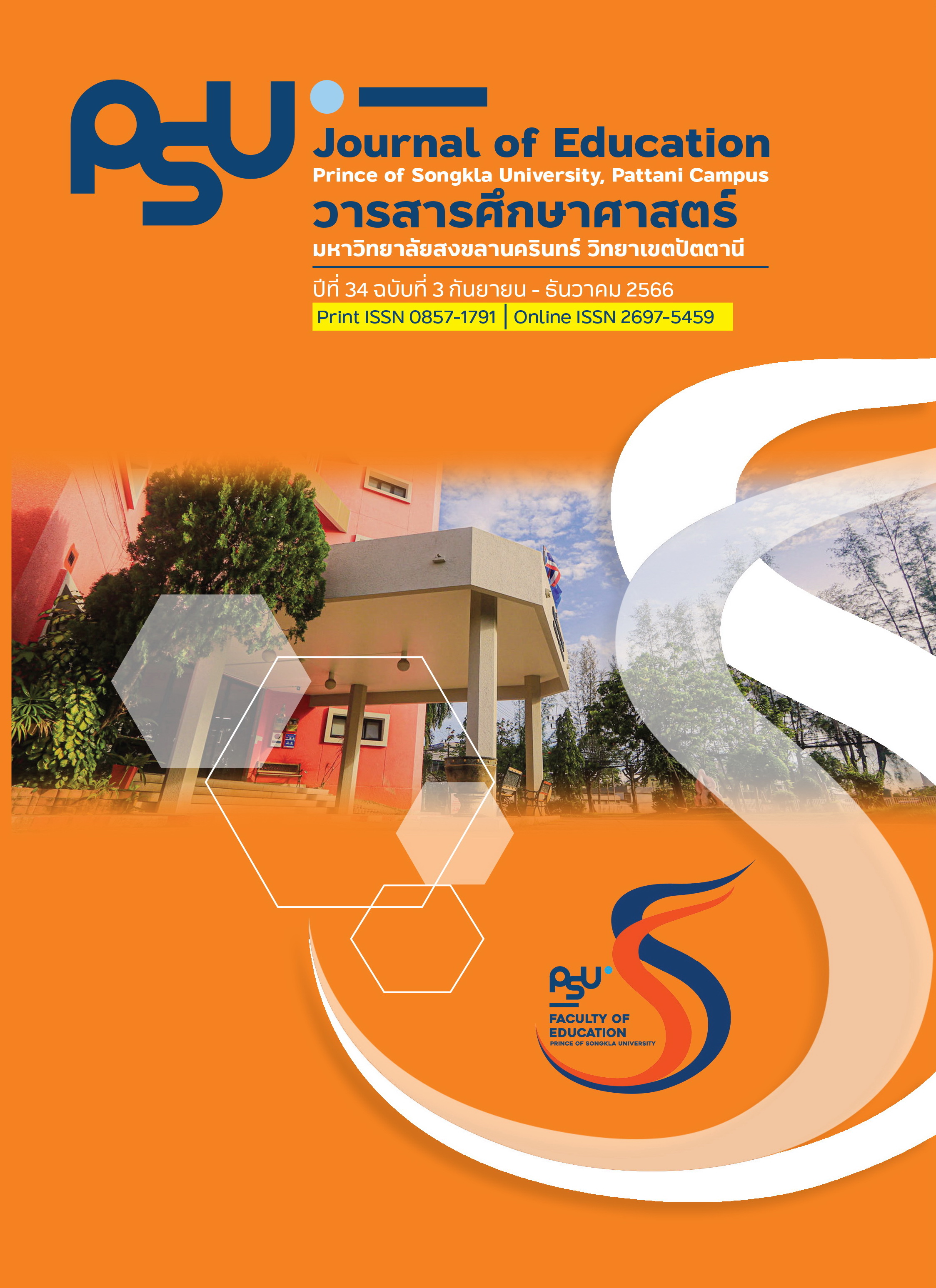การพัฒนาแอปพลิเคชันความเป็นจริงเสริมเพื่อส่งเสริมทักษะการเรียนรู้คำศัพท์ภาษาจีนสำหรับนักเรียนชั้นมัธยมศึกษาตอนต้น
Main Article Content
บทคัดย่อ
การวิจัยครั้งนี้เป็นการวิจัยและพัฒนามีวัตถุประสงค์เพื่อ 1) พัฒนาแอปพลิเคชันความเป็นจริงเสริมเพื่อส่งเสริมทักษะการเรียนรู้คำศัพท์ภาษาจีนสำหรับนักเรียนให้มีประสิทธิภาพตามเกณฑ์ 85/85 2) เพื่อศึกษาผลสัมฤทธิ์ทางการเรียนของนักเรียนที่เรียนด้วยแอปพลิเคชันความเป็นจริงเสริม 3) เพื่อศึกษาความพึงพอใจของนักเรียนที่มีต่อแอปพลิเคชันความเป็นจริงเสริม 4) เพื่อศึกษาความคงทนในการเรียนรู้คำศัพท์ภาษาจีน ประชากร ได้แก่ นักเรียนชั้นมัธยมศึกษาตอนต้น กลุ่มตัวอย่าง ได้แก่ นักเรียนชั้นมัธยมศึกษาปีที่ 1 ในจังหวัดภูเก็ต พังงา และกระบี่ ที่เรียนวิชาภาษาจีน สุ่มตัวอย่างแบบหลายขั้นตอน จำนวน 6 โรงเรียน รวม 180 คน เครื่องมือที่ใช้ ได้แก่ 1) แอปพลิเคชันความเป็นจริงเสริมเพื่อส่งเสริมทักษะการเรียนรู้คำศัพท์ภาษาจีน 2) แบบทดสอบผลสัมฤทธิ์ทางการเรียน 3) แบบสอบถามความพึงพอใจของผู้เรียน 4) แบบทดสอบวัดความคงทนในการเรียนรู้คำศัพท์ภาษาจีน สถิติที่ใช้ในการวิเคราะห์ข้อมูล ได้แก่ ค่าเฉลี่ย ส่วนเบี่ยงเบนมาตรฐาน และ t-test
ผลการวิจัยพบว่า 1) แอปพลิเคชันความเป็นจริงเสริมเพื่อส่งเสริมทักษะการเรียนรู้คำศัพท์ภาษาจีนได้รับการประเมินคุณภาพจากผู้เชี่ยวชาญในระดับมากที่สุด มีค่าประสิทธิภาพสูงกว่าเกณฑ์ที่กำหนด 2) คะแนนผลสัมฤทธิ์ทางการเรียนของผู้เรียนที่เรียนด้วยแอปพลิเคชันความเป็นจริงเสริมหลังเรียนสูงกว่าก่อนเรียนอย่างมีนัยสำคัญทางสถิติที่ระดับ .05 3) ความพึงพอใจของนักเรียนที่มีต่อแอปพลิเคชันความเป็นจริงเสริม อยู่ในระดับมาก 4) นักเรียนมีความคงทนในการเรียนรู้คำศัพท์ภาษาจีนหลังเรียน และค่าเฉลี่ยผลสัมฤทธิ์ทางการเรียนรู้คำศัพท์ภาษาจีนพื้นฐานหลังเรียน 2 สัปดาห์ มีค่าไม่แตกต่างกัน
Article Details

อนุญาตภายใต้เงื่อนไข Creative Commons Attribution-NonCommercial 4.0 International License.
เอกสารอ้างอิง
Akkeedei, A. (2020). The Development of Augmented Reality media in musical instrumen t for grade 4 students of Srinakharinwirot Ongkharak Demonstration Sc hool. Faculty of Fine Arts, Srinakharinwirot University. [in Thai]
China. (2020). Access. https://www.Prachachat.net/world-news.19.12.2020
Insee, N. & Malisuwan, S. (2008). Virtual Reality System-VR. http://www.nextproject.net/contents/defaulf.aspx/00100. [in Thai]
Kalapan, W. (2013). A study of learning achievement and retention of Mattayomsuksa 2 students of the lives and works of famous Thai people by kwdl technique. Faculty of Education, Silpakorn University. [in Thai]
Limpinan, P. (2017). Using Augmented Reality (AR) for Encouraging the Retention of Learning English Vocabulary. Faculty of Information Technology, Rajabhat Mahasarakham University. [in Thai]
Ministry of Education. (2008). The Basic Education Core Curriculum B.E. 2551 (A.D. 2008). Bangkok: Kurusapa Ladprao Publishing. [in Thai]
Ministry of Education. (2016). Report for the development of Chinese language teaching in Thailand at the secondary level. Bangkok: Ministry of Education. [in Thai]
Pariyawatid. P. (2015). Effecting Augmented Reality Code of Chinese Vocabularies Lesson for Grade 3 Students at Tessaban 2 Wattaninarasamosorn School. Faculty of Education, Prince of Songkla University. [in Thai]
Puttidate, A. (2018). The Development of application of finite integrals by applying augmented reality techniques on mobile phones and smartphones. Faculty of Science and Technology, Rajamangala University of Technology Suvarnabhumi. [in Thai]
Sinno, P. (2015). An Augmented Reality Instructional Package on Plant Types for Prathomsuksa 5 Students. Faculty of Technical Education, Rajamangala University of Technology Thanyaburi. [in Thai]
Sonkanok, A. & Sanpit, S. (2018). Development of Augmented Reality Multimedia for Distance Education of Sukhothai Thammathirat Open University. Sukhothai Thammathirat Open University. [in Thai]
Surathamjanya, R. (2016). The Result of Using Application for Teaching English Vocabulary on Tablet in English Subject for Prathomsuksa 2 Students in Ratchaburi Ed ucation Service Area 2. Faculty of Education, Silpakorn University. [in Thai]
Techakosit, S. & Piriyasurawong, P. (2015). Constructionist learning and teaching using augmented reality technology for science subject. Technical Education Journal King Mongkut’s University of Technology North Bangkok, 6(1), 225-230.


